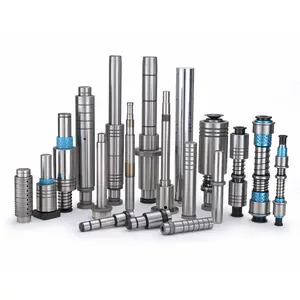Introduction to Bushings Guide
Bushings are essential components used in various mechanical systems to facilitate movement and absorb shock, thereby enhancing the longevity and functionality of machinery. The bushings guide serves as an informative resource for understanding these critical components, their types, applications, features, and advantages. Through this guide, you will gain a clearer insight into how bushings function and how they can be utilized effectively in various industries.
Types of Bushings Guide
Understanding the different types of bushings is crucial for selecting the right component for specific applications. The bushings guide categorizes bushings into several types based on their materials and designs:
- Bronze Bushings: Renowned for their durability and wear resistance, typically used in high-friction applications.
- Plastic Bushings: Lightweight and resistant to corrosion, ideal for applications in humid environments.
- Rubber Bushings: Excellent for vibration dampening and noise reduction, commonly used in automotive and machinery settings.
- Composite Bushings: Made from advanced materials, offering superior strength and resistance to harsh environments.
Function and Feature of Bushings Guide
The bushings guide elaborates on the primary functions and notable features of bushings, shedding light on their significance in mechanical systems:
- Load Distribution: Bushings help distribute weight and stress evenly across surfaces, minimizing wear and tear.
- Friction Reduction: They serve as sliding elements, reducing friction between moving parts, thus improving efficiency.
- Shock Absorption: Bushings act as cushions, absorbing shocks and vibrations to protect machinery from damage.
- Alignment: They help in maintaining alignment between rotating and stationary components, ensuring smoother operations.
Applications of Bushings Guide
The versatility of bushings allows them to be employed in various industries and applications. The bushings guide outlines these key areas:
- Automotive: Used in suspension systems, steering columns, and drive shafts to enhance vehicle performance.
- Manufacturing Machinery: Essential in conveyor systems, robotic arms, and assembly lines for smoother movement and reduced wear.
- Aerospace: Critical components for aircraft systems, ensuring safety and reliability through effective vibration control.
- Construction Equipment: Employed in hydraulic systems and excavators to provide stability and absorb shocks during operation.
Advantages of Using Bushings Guide
Incorporating bushings into mechanical designs brings numerous advantages. The comprehensive bushings guide highlights these benefits:
- Enhanced Durability: The right bushing can significantly extend the lifespan of machinery by reducing wear on components.
- Improved Performance: By minimizing friction and facilitating smoother operations, bushings enhance the overall performance of systems.
- Cost-Effectiveness: Less frequent maintenance and replacement due to reduced wear can lead to significant cost savings over time.
- Easier Installation: Many bushings are designed for straightforward installation, making it simpler to replace or upgrade as needed.
By utilizing the bushings guide, you can make informed decisions in selecting the right bushings that suit your specific application, ensuring optimal performance and longevity for your machinery.
















































